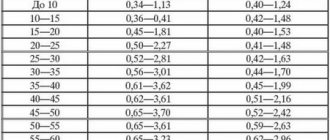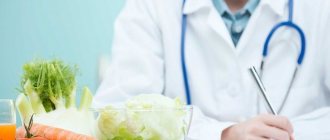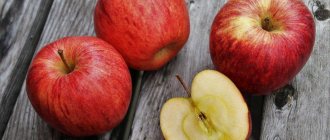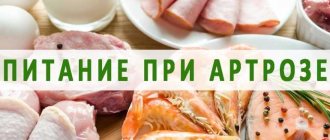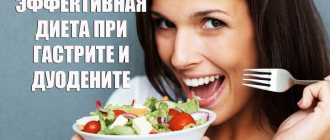Impaired lipid metabolism leads to an increase in serum cholesterol concentrations. Hypercholesterolemia is a dangerous condition for both women and men. In this situation, an anti-cholesterol diet will come to the rescue. This article examines the questions: “What is this?”, “What foods can you eat?”, “What should be an approximate menu for the week?”
Diet for high cholesterol in women, cholesterol formation:
Cholesterol formation occurs mainly in the liver in the presence of bile acids. Cholesterol is absorbed in the intestine and excreted by the colon.
The fat that forms on our anterior abdominal wall literally envelops all internal organs, intra-abdominal pressure increases and the functioning of these organs is disrupted.
But in order to determine whether your cholesterol and its fractions are normal or not, you need to take a blood test from a vein on an empty stomach in your clinic to understand what diet is right for you for high cholesterol in women.
Table of foods for a hypocholesterol diet
An anti-cholesterol diet involves dividing foods into several groups: Some of them can be eaten at least every day, others should be consumed in moderation, and others should be removed from your menu once and for all. All of them are indicated in the table, which is considered a reminder for the patient.
All product categories are marked in blue. Foods that can be consumed daily are highlighted in green. Products that are best avoided are indicated in yellow. Products that are prohibited for plaques in blood vessels are marked in red. After studying this table, you can get an idea of proper nutrition. This will help normalize serum cholesterol levels.
Blood cholesterol levels in women:
For more information about taking a cholesterol test and its detailed explanation, read the article “Cholesterol Testing”:
| Cholesterol fractions | Norm |
| Total cholesterol | Up to 5.2 mm/l. |
| Triglycerides | Up to 1.8 mm/l. |
| HDL (good cholesterol) | More than 1.4 mm/l. |
| LDL (bad cholesterol) | Up to 3.9 mm/l. |
| Atherogenic index | Up to 3.0. |
Fully or partially limited products
When following an anti-cholesterol diet, the following are excluded from the diet:
- Fatty red meats, offal, waterfowl meat (duck, goose), sausages, smoked meats, animal/cooking fats.
- Meat/fish broths, canned fish, fried foods, fish roe, crayfish, crabs, shrimp, cod liver.
- Cream pies, cakes, pastries, puff pastry products.
- Semolina, white rice, pasta.
- Full-fat cottage cheese, cheese, sour cream and cream, chicken egg yolks, products with palm/coconut oil.
- Chocolate, cocoa, ice cream, strong black tea/coffee.
- Products containing easily digestible carbohydrates - honey, jam, jam, sugar, confiture.
Table of prohibited products
| Proteins, g | Fats, g | Carbohydrates, g | Calories, kcal | |
Fruits | ||||
| bananas | 1,5 | 0,2 | 21,8 | 95 |
Nuts and dried fruits | ||||
| raisin | 2,9 | 0,6 | 66,0 | 264 |
Cereals and porridges | ||||
| semolina | 10,3 | 1,0 | 73,3 | 328 |
| white rice | 6,7 | 0,7 | 78,9 | 344 |
Flour and pasta | ||||
| pasta | 10,4 | 1,1 | 69,7 | 337 |
Bakery products | ||||
| bagels | 16,0 | 1,0 | 70,0 | 336 |
| bagels | 16,0 | 1,0 | 70,0 | 336 |
| crackers | 11,2 | 1,4 | 72,2 | 331 |
Confectionery | ||||
| jam | 0,3 | 0,2 | 63,0 | 263 |
| jam | 0,3 | 0,1 | 56,0 | 238 |
| candies | 4,3 | 19,8 | 67,5 | 453 |
| pastry cream | 0,2 | 26,0 | 16,5 | 300 |
Ice cream | ||||
| ice cream | 3,7 | 6,9 | 22,1 | 189 |
Cakes | ||||
| cake | 4,4 | 23,4 | 45,2 | 407 |
Chocolate | ||||
| chocolate | 5,4 | 35,3 | 56,5 | 544 |
Raw materials and seasonings | ||||
| ketchup | 1,8 | 1,0 | 22,2 | 93 |
| mayonnaise | 2,4 | 67,0 | 3,9 | 627 |
Dairy | ||||
| cream | 2,8 | 20,0 | 3,7 | 205 |
| sour cream 30% | 2,4 | 30,0 | 3,1 | 294 |
| sour cream 40% (fat) | 2,4 | 40,0 | 2,6 | 381 |
Cheeses and cottage cheese | ||||
| cheese | 24,1 | 29,5 | 0,3 | 363 |
| cottage cheese 18% (fat) | 14,0 | 18,0 | 2,8 | 232 |
Meat products | ||||
| pork | 16,0 | 21,6 | 0,0 | 259 |
| pork liver | 18,8 | 3,6 | 0,0 | 108 |
| pork kidneys | 13,0 | 3,1 | 0,0 | 80 |
| pork fat | 1,4 | 92,8 | 0,0 | 841 |
| salo | 2,4 | 89,0 | 0,0 | 797 |
| beef liver | 17,4 | 3,1 | 0,0 | 98 |
| beef kidneys | 12,5 | 1,8 | 0,0 | 66 |
| beef brains | 9,5 | 9,5 | 0,0 | 124 |
| mutton | 15,6 | 16,3 | 0,0 | 209 |
Sausages | ||||
| smoked sausage | 16,2 | 44,6 | 0,0 | 466 |
| smoked sausage | 9,9 | 63,2 | 0,3 | 608 |
| sausages | 10,1 | 31,6 | 1,9 | 332 |
| sausages | 12,3 | 25,3 | 0,0 | 277 |
Bird | ||||
| smoked chicken | 27,5 | 8,2 | 0,0 | 184 |
| duck | 16,5 | 61,2 | 0,0 | 346 |
| smoked duck | 19,0 | 28,4 | 0,0 | 337 |
| goose | 16,1 | 33,3 | 0,0 | 364 |
Fish and seafood | ||||
| smoked fish | 26,8 | 9,9 | 0,0 | 196 |
| salted fish | 19,2 | 2,0 | 0,0 | 190 |
| Red caviar | 32,0 | 15,0 | 0,0 | 263 |
| black caviar | 28,0 | 9,7 | 0,0 | 203 |
| squid | 21,2 | 2,8 | 2,0 | 122 |
| shrimps | 22,0 | 1,0 | 0,0 | 97 |
| salmon | 19,8 | 6,3 | 0,0 | 142 |
| sturgeon | 16,4 | 10,9 | 0,0 | 163 |
| canned fish | 17,5 | 2,0 | 0,0 | 88 |
| semi-finished fish products | 12,5 | 6,7 | 14,7 | 209 |
| sardine | 20,6 | 9,6 | — | 169 |
| mackerel | 18,0 | 13,2 | 0,0 | 191 |
| cod (liver in oil) | 4,2 | 65,7 | 1,2 | 613 |
| boiled oysters | 14,0 | 3,0 | — | 95 |
| fresh oysters | 14,0 | 6,0 | 0,3 | 95 |
Oils and fats | ||||
| butter | 0,5 | 82,5 | 0,8 | 748 |
| creamy margarine | 0,5 | 82,0 | 0,0 | 745 |
| coconut oil | 0,0 | 99,9 | 0,0 | 899 |
| palm oil | 0,0 | 99,9 | 0,0 | 899 |
| rendered beef fat | 0,0 | 99,7 | 0,0 | 897 |
| cooking fat | 0,0 | 99,7 | 0,0 | 897 |
| rendered pork fat | 0,0 | 99,6 | 0,0 | 896 |
Non-alcoholic drinks | ||||
| cola | 0,0 | 0,0 | 10,4 | 42 |
| lemonade | 0,0 | 0,0 | 6,4 | 26 |
| Pepsi | 0,0 | 0,0 | 8,7 | 38 |
| sprite | 0,1 | 0,0 | 7,0 | 29 |
| * data is per 100 g of product | ||||
Diet for high cholesterol in women, what to avoid:
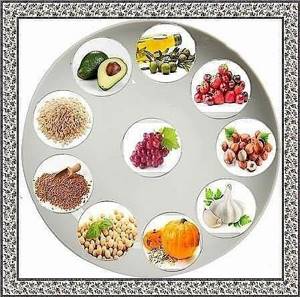
The ratio is broken:
- Violation of the ratio of cholesterol and lecithin.
- The balance between the consumption of saturated and unsaturated fats is disrupted.
- Vitamin D and ascorbic acid.
- Vitamins D, C, A, and E.
- Increasing the permeability of the vascular wall.
- Functions of the endocrine glands (thyroid, pancreas, reproductive).
- Content of folic acid and vitamin B 12 in food.
- Microelements manganese and copper.
This discrepancy between the ratios listed above contributes to the penetration of cholesterol-protein complexes into the inner lining of blood vessels.
Scientifically proven if you want to live long and be healthy.
Need to:
- Exercise.
- Pay close attention to plant-based foods. This is very healthy: legumes (peas, lentils).
- Eat more eggplants, pearl barley is very healthy (hand on heart, tell me, do you eat it often?). We eat mainly wheat products.
Superfoods that help lower cholesterol:
- Any porridge.
- Nuts.
- Pearl barley.
- Buckwheat.
- Brown rice, long grain rice, brown rice.
- Vegetables (eggplant).
Reviews and results of losing weight
I started using the diet after a medical examination. Due to high cholesterol, problems with the thyroid gland began. At the moment, my health has returned to normal, and with the help of a diet I have lost some excess weight. Grade:
Marina, 28 years old
I use foods that do not contain animal fats; everything is steamed. This method allows you to significantly improve your well-being. Grade:
Oleg, 33 years old
With the help of a low cholesterol diet, I lost excess weight and improved the appearance of my figure. In addition, constant fatigue and nervous tension disappeared. I have been following the diet for one month now. Grade:
Natasha, 37 years old
Seven golden rules of diet for high cholesterol in women:

- Reduce your overall fat intake.
- Severely limit your intake of saturated fats (butter, cream, eggs, animal fats). They are the most dangerous.
- Increase your consumption of foods rich in polyunsaturated fatty acids. They are good at reducing blood lipid levels (vegetable oils, low-fat fish, skinless poultry, seafood). But you still need to know the norm, no more than 30 grams per day.
- Increase your intake of plant fiber (up to 35 mg/day). Increase your intake of complex carbohydrates (vegetables, fruits, berries).
- Replace butter with vegetable oil when cooking.
- Severely limit foods rich in cholesterol (refractory fats, fatty meats, fish, etc.).
- Limit salt intake to 3-5 g/day. Add salt to food on the table.
Rules for creating a menu
The purpose of the diet is to normalize metabolism, prevent excess fat deposition, and create favorable conditions for blood circulation.
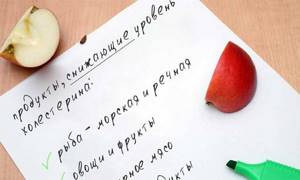
The basis of the diet for women is based on simple rules:
- Breakfast – here it is advisable to adhere to the principle of separate meals. In the mornings, they eat either carbohydrates (porridge, whole grain bread, fruits) or proteins (eggs, omelet, cottage cheese). Breakfasts alternate.
- Lunch is a light snack consisting of proteins and carbohydrates. Maintains tone, compensates for energy costs, relieves hunger. A good option is fruit salad, freshly squeezed vegetable juice, nuts.
- Lunch – protein, fiber. If the first is cooked with chicken, veal, the second is vegetables without meat.
- Afternoon snack – protein. Cottage cheese, chicken without side dish, yogurt, toast are suitable.
- Dinner – proteins, carbohydrates. Fish, chicken, cereal side dish or vegetables.
- Just before going to bed, it is advisable to drink a glass of kefir, fermented baked milk, or yogurt.
The daily amount of water is drunk during the day between meals.
Diet for high cholesterol in women, fiber:
Water-soluble fiber (pectin, gluten) reduces blood cholesterol levels by 15% or more. It helps reduce the absorption of cholesterol in the intestines. The secretion of bile acids in feces increases, which enhances cholesterol metabolism.
The daily intake of water-soluble fiber is 15 grams, which is:
Select one name:
- 1 cup beans.
- 1 cup oat bran.
- 1 cup peas and other legumes.
- 500 grams of apples.
- 500 grams of cabbage.
- 500 grams of carrots.
Recipes for a hypocholesterol diet
It is quite easy to diversify the menu during a hypocholesterol diet, since there are quite a lot of foods that are allowed to be consumed. For daily use, such popular dishes as: okroshka, only instead of sausage you can cut boiled chicken fillet or lean veal, vegetable stew with rabbit, risotto with mushrooms and vegetables, cheesecakes, seafood salad, gazpacho, pilaf with dried apricots and prunes and much more. other delicious dishes.
Syrniki
To prepare such a tasty and healthy dish you will need:
- low-fat cottage cheese - 300 grams;
- semolina - 2 tablespoons;
- flour - 4 tablespoons;
- egg white - 2 pieces;
- soda - 1 teaspoon.
Beat the whites with a small amount of sugar, add grated cottage cheese. Then add flour, soda and semolina to the mixture and stir until a homogeneous consistency is obtained. Spoon the resulting mixture onto a baking sheet lined with foil or parchment and cook in the oven at 180 degrees for 15 minutes.
Gazpacho
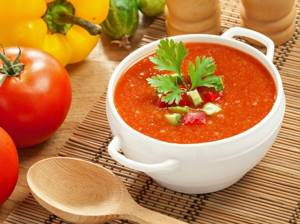
Gazpacho is a cold Spanish soup made from pureed raw vegetables. To prepare it you will need:
- large fleshy tomatoes - 3 pieces;
- cucumber - 1 piece;
- sweet bell pepper - 1 piece;
- white bread - 1 slice;
- garlic - 2 cloves;
- olive oil - 1 tablespoon;
- salt;
- spices;
- ice.
Place the tomatoes in boiling water for a few seconds to make it easier to remove the skin. Soak the bread in warm water. Peel the vegetables and place in a blender along with the bread. Grind everything until you obtain a homogeneous puree-like consistency. Place on plates, add olive oil and herbs. In summer, it is recommended to add a little ice to this soup.
Sweet pilaf
To prepare such an easy and tasty dish you will need:
- brown rice - 250 grams;
- dried apricots - 200 grams;
- carrots - 1 piece;
- prunes - 100 grams;
- apple - 1 piece.
Rice must be boiled before cooking. Cut the apple, carrots and dried fruits into small strips. It is advisable to pre-soak dried fruits for a few minutes. In a cauldron, fry chopped dried fruits, carrots and apples, add boiled rice, stir. Add water and simmer until it evaporates completely.
Cholesterol-lowering foods:
- Vegetable oils.
- Soft-boiled eggs (no more than 1 per week).
- Chicken breast.
- Vegetables (especially cabbage).
- Porridge (except semolina).
- Fish.
- Nuts.
- Mushrooms (contain statins).
- Oranges, apples.
- Dry red wine (one glass per day) contains antioxidants.
Diet tips for high cholesterol if diets don't work:

- Check the package inserts for your medications; many blood pressure pills increase cholesterol levels in the blood. The annotation should not indicate that when applied you will have the word “hyper”. This word means high cholesterol.
- Get out into the sun and take walks more often. In this case, vitamin D is formed from cholesterol. In this case, you will receive double benefits: strengthen your bones and reduce cholesterol levels in the blood.
- Drink at least 1 liter of clean water, this helps to perfectly cleanse the body, remove excess cholesterol and flush the kidneys.
- Use entorosorbents, they help remove toxins from the body, including cholesterol: polyphepan, enterosgel, etc. If it’s expensive, use activated carbon 1 tablet. per 10 kg of human live weight. It is best to use them in short courses. Drink for 3-4 days and take a break for 14 days. Repeat. Treat for 3 months and take a break for 3 months.
- Reduce in your diet, or better yet eliminate: fast food, processed meats, cold cuts, sausages, sausages, sausages. These products contain hidden salt and all sorts of additives, which increases blood cholesterol levels.
- Treat yourself with medicinal leeches (hirudotherapy), they thin the blood very well and lower cholesterol. Do not forget to check your individual tolerance to the procedure.
- Reduce the number of cigarettes you smoke, quitting smoking is even better, but not everyone can.
- Reduce your coffee consumption to 1-2 cups a day, or better yet, give it up completely. Even if a person drinks decaffeinated coffee, cholesterol levels increase.
- Get examined and treat concomitant diseases, each of which can lead to increased cholesterol levels in the blood. Check your kidneys and liver, check your gallbladder. Be sure to visit an endocrinologist.
- If a diet for high cholesterol in women does not give the expected result, you can try to apply your mentioned tips for yourself.
Principles and essence of the anti-cholesterol diet
Cholesterol is a substance of the fatty alcohol class. Its normal concentration is maintained by the endogenous fraction (which is produced by liver cells) and exogenous (comes from the outside through food). With poor nutrition, when the diet is dominated by products rich in animal fats, this balance is disrupted. The concentration of cholesterol in the blood plasma gradually increases. This condition eventually leads to the development of atherosclerosis, which is dangerous due to its complications.
A cholesterol-free diet helps quickly improve lipid metabolism. A cholesterol-free diet helps normalize this indicator in the blood serum in atherosclerosis. There are principles without which the diet will be ineffective:
- During the day, it is optimal to eat at least 5-6 times, but the size of one serving should not exceed 250 grams;
- dinner no later than 4 hours before going to bed;
- the daily norm of drinking water is 2–3.5 liters - internal organs cope with the excess fat component faster;
- nutrition should be limited in salt - a low-salt diet eliminates the accumulation of fluid and cholesterol in the body;
- heat treatment of food according to dietary recipes should be carried out by boiling, baking, or cooking with steam;
- a person following this diet needs to get rid of bad habits (smoking tobacco, drinking alcoholic beverages);
- You should exercise regularly and walk in the fresh air.
Before you start fighting high cholesterol, you should visit a nutritionist. This must be done to calculate the body mass index and determine the ratio of fat and muscle tissue in the body. A nutritionist will help you individually choose a suitable diet.
Foods that lower and increase cholesterol:
| Cholesterol lowering | Cholesterol-raising |
| Oatmeal | Beef brains |
| Oat bran | Red caviar |
| Salmon | Granular caviar |
| Almond | Liver, pates |
| Olive oil | Butter |
| Soybeans | Language |
| Dry red wine | Shrimp, crabs |
| Flax seed | Veal |
| Citrus | Hard cheese |
| Vegetables | Chicken with skin |
| Green tea | Mackerel |
| Peanut butter | Margarine |
| Garlic | Sausage |
| Walnuts, pistachios | Cream |
| Barley | Fast food |
| Dark chocolate |
Diet for high cholesterol in women, allowed foods:

Prohibited foods for following a diet for high cholesterol in women:
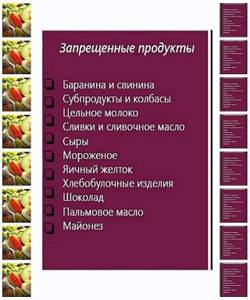
Nutritional features by age
The main reason for increased cholesterol is the abuse of fatty foods, fast food, lack of a routine, frequent overeating or strict diets. Up to 30 years of age, the risk is minimal due to active metabolic processes. The risk of hypercholesterolemia increases proportionally with age.
Women 30-40 years old
Excessive deviation of cholesterol from the norm is rarely detected. The main reasons: slowdown of metabolic processes, poor nutrition, lack of mobility. Fat particles do not have time to be eliminated from the body and begin to be stored as reserves. It is often at this age that women begin to gain extra pounds.
It is advisable that the basis of the diet be foods containing many antioxidants:
- green tea, vegetable juices;
- ginger;
- soy;
- eggplants, carrots, pumpkin, zucchini;
- poultry, red fish;
- buckwheat, rolled oats, brown rice.
Such products support metabolic processes, ability to work, and calm the nervous system.
Women 40-50 years old
After 40 years, cholesterol concentration doubles. The body begins to gradually prepare for menopause, so it reduces estrogen synthesis. Long-term disruptions in lipid metabolism can cause the development of other, more serious diseases: atherosclerosis, arthritis, thyroid and kidney dysfunction.
The menu must include foods rich in iodine, fatty acids, and lactic acids. It is not advisable to eat veal more than once a week; chicken and turkey meat can be eaten no more than 2 times.
Women 50-60 years old
After 50 years, in 90% of cases, increased cholesterol is caused by acquired chronic diseases. Poor nutrition, lack of mobility, and age-related changes in blood vessels increase the risk of atherosclerosis and heart disease.
Therefore, a diet for high cholesterol levels in women after 50 years of age should consist of vegetables, fruits, fish dishes, and dairy products. It is advisable to completely eliminate sugar and salt.
Women 60-70 years old
After 60 years, hormonal levels normalize. The minimal amount of estrogen produced by the body does little to protect the arteries from atherosclerotic plaques. Waste, toxins, and bad cholesterol quickly accumulate. Vessels become less elastic, fragile, and excessively permeable.
Vegetables, herbs, fruits, and whole grains help maintain metabolism. If possible, it is advisable to completely abandon meat, replacing it with fish. Dairy and fermented milk products are consumed 1-2 times a week.
Women over 70 years old
Normally, the amount of cholesterol should decrease. Its excess poses a serious threat to the heart. The risk of senile vascular atherosclerosis, heart attack, and stroke increases. Very often, dyslipidemia appears against the background of chronic diabetes mellitus and hypertension.
The need for proteins decreases, but their absence accelerates age-related changes. The necessary substances are obtained from dairy products with a fat content of 1-2% and fish. Poultry meat is moderately limited, consuming it once a week. The basis of the diet should still be vegetables (legumes are excluded), fruits, and whole grain cereals.
Why is cholesterol dangerous?
The World Health Organization has concluded that cholesterol is one of the causes of atherosclerosis. Indeed, when there is an excess of it, plaques form on the inner walls of blood vessels, which reduce their diameter and, accordingly, reduce their throughput. As a rule, pain and dysfunction of organs due to atherosclerosis occur only when the blood vessels are blocked by two-thirds or more. This poses a serious threat, since atherosclerosis is the basis of many diseases of the cardiovascular system - stroke, myocardial infarction, coronary heart disease, thrombosis and others. Therefore, if your doctor recommended you such a diet as a cholesterol-free diet, you should carefully consider his advice.

Advantages and disadvantages
| pros | Minuses |
|
|
Oils and nuts: which ones to choose?
Butter and margarine contain the same amount of fat (up to 81 g per 100 g), but these fats differ in their composition. Butter contains a lot of saturated fatty acids (about 63%) and about 4% of so-called trans fatty acids (partially hydrogenated vegetable fats). Trans fatty acids are recognized as harmful to health.
Compared to butter, all types of margarines contain lower amounts of saturated fatty acids, and margarines labeled “high in polyunsaturated acids” contain a large amount of trans fatty acids, which, along with saturated fats, cannot be recommended in the diet of patients with hypercholesterolemia.
Olive oil is an ideal product from the point of view of the concept of the so-called Mediterranean diet and low cholesterol nutrition. Olive oil is absorbed by the body by 98%, while sunflower oil is only 65%.
Olive oil has been used by humans for thousands of years and is considered one of the oldest foods. Like wine, olive oil comes in different flavors, colors and aroma as it is grown in different climates and soils and harvested in different ways.
Olive oil is divided into several grades based on flavor and acidity. Extra Virgin Olive Oil is produced from selected quality olives. It has excellent taste and aroma and does not require cleaning. The acidity of this oil is no more than 1%.
“Virgin Olive Oil” is also an excellent product that does not require purification. It has a high standard of taste and aroma, and its acidity is no more than 2%.
“Olive oil” is an oil that initially has a high percentage of acidity. It is processed (refined) and flavored with “super natural” olive oil. Its acidity is no more than 1.5%.
Olive oil can serve as a salad dressing, a marinade for meat and fish, it is resistant to high temperatures and is widely used for frying and baking.
Nuts are a very healthy and nutritious product. Nuts contain a large amount of calories, vegetable protein and unsaturated fatty acids. Recent evidence suggests that eating certain types of nuts (such as walnuts) leads to a modest reduction in cholesterol by up to 12%.
Brazil nuts are an excellent source of selenium. Selenium is an important trace element that is involved in oxidative processes, normal thyroid function and the production of the sex hormone testosterone, and also ensures normal sperm motility. Three whole Brazil nuts (10 g) provide the daily dose of selenium - 153 mcg (daily value for men - 75 mcg, for women - 60 mcg).
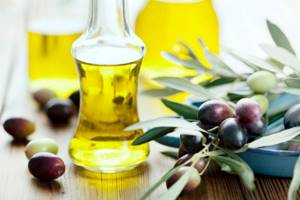
Detailed description of the diet
Having seen an overestimation of total cholesterol values (a table by age and gender is attached) in the analysis, people immediately ask the doctor how to eat, what they can eat, what fruits and vegetables help lower cholesterol, or what foods are rich in microelements.
A cholesterol-lowering diet (or anti-atherosclerotic diet) is a complete diet in which it is necessary to control the consumption of carbohydrates and animal fats. Proper nutrition + a healthy lifestyle, morning exercises are the key to quickly restoring cholesterol levels, normalizing blood pressure and weight. For a successful result, you should follow all the recommendations of your doctor.
Diet to lower cholesterol (required in the diet):

- legumes (peas, beans, etc.);
- pasta (durum wheat);
- lean meat (except pork);
- low-fat sea fish (cod, flounder, tuna, hake);
- unrefined vegetable oil (palm oil is prohibited);
- milk, low-fat fermented milk products;
- cereals;
- bakery products of coarse grinding, with bran;
- egg whites;
- vegetables: pumpkin, cabbage, potatoes, beets, carrots (raw, baked, steamed, boiled);
- onion, garlic, horseradish;
- spices;
- walnuts;
- dried peanuts;
- fruits (fresh, frozen, dried).
A sample menu for the week can be compiled from the options described below.
First breakfast
- boiled egg white, oatmeal (cooked in milk and water), baked potatoes, boiled veal, green tea;
- buckwheat porridge, boiled (skinless) chicken breast, vegetable salad, rose hip decoction;
- pearl barley, steamed fish, salad, unsweetened compote.
Lunch
- apple-carrot salad;
- fresh apple, low-fat cottage cheese;
- yogurt, nuts or dried fruits.
Dinner
- pumpkin puree soup (classic), stew, chop;
- borscht in low-fat broth (with meat), meatballs, beans;
- soup with wheat cereal, fish cutlet, baked potatoes.
Afternoon snack
- jelly, fruit;
- tea, cottage cheese;
- tea, dried fruits, nuts.
- Dinner:
- milk porridge, herbal tea;
- vegetable salad, fish;
- pasta, boiled meat.
At night, drink low-fat kefir.
History of the discovery of cholesterol
In 1769, Pouletier de la Salle, a French chemist, was able to isolate a dense white substance from gallstones that has many of the properties of fats. He called his find a “fat wax.” In 1789, another Frenchman, member of the National Convention Antoine Francois de Fourcroix, obtained this substance in its pure form. And only in 1815 the name “cholesterol” arose. It was invented by French organic chemist Michel Chevreul by combining the word “bile” (“chole”) with the word “fatty” (“sterol”). However, cholesterol is not a fat: in 1859, another Frenchman, Pierre Berthelot, proved that the substance belongs to the class of alcohols, so since 1900 it has been called cholesterol. In Russia this name did not take root.
